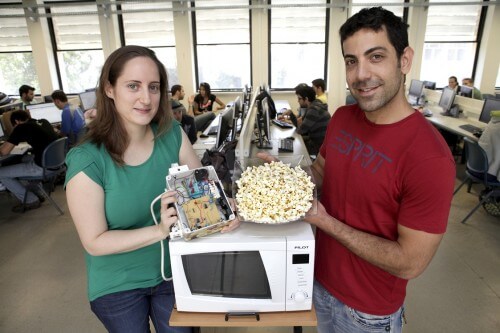A mobile application that warns drivers of speed signs, an acoustic detector that detects when the popcorn in the microwave is ready, a simulator for training surgeons and a system that helps with correct posture. All of these are among the developments presented by the students of the computer engineering and computer engineering departments specializing in applied physics from the Benin School of Engineering and Computer Science at the Hebrew University

A mobile application that warns drivers of speed signs, an acoustic detector that detects when the popcorn in the microwave is ready, a simulator for training surgeons and a system that helps with correct posture. All of these are among the developments presented by the students of the computer engineering and computer engineering departments specializing in applied physics from the Benin School of Engineering and Computer Science at the Hebrew University, as part of a final project presentation ceremony.
According to Prof. Aharon Agrant from the Department of Computer Engineering specializing in Applied Physics, "The Departments of Computer Engineering at the Hebrew University strive to train their graduates to be the leaders of R&D at the forefront of future technology in a world that is required to face a variety of challenges such as green energy sources, and providing advanced medicine to all. Our students combine the knowledge of scientists with the ability of engineers and the final project gives them a third element - the creativity of inventors.
The app that will save you quick reports:
The students Yanon Galia and David Kranzdorf developed an Android application that will automatically detect speed signs while driving and inform the driver of the speed limit. Using algorithms for image processing, the camera of the mobile device recognizes in real time the shape of caution signs, reads the number appearing on them and transmits a voice message to the driver regarding the permitted speed.
"The idea for the app arose from a personal need," says Kranzdorf. "When I was abroad, I noticed that the GPS devices often give incorrect or late speed alerts because they are based on out-of-date databases. That's why our idea was to develop software that would not depend on all kinds of old databases but would tell the driver what the situation is at the moment." According to Kranzdorf, "There are already advanced devices on the car market that help the driver and provide a variety of alerts, but the problem is that they cost thousands of shekels. Our goal was to offer drivers a cheap and simple solution and we have intentions to make the development commercial."
The detector that will take care of your popcorn:
Orit Gutman, Guy Gaziv and Alex Segidkovski developed an acoustic radar that detects at what stage all the popcorn in the microwave is ready and stops its activity in order not to burn the popcorn for nothing. The device is based on a detector that monitors the crackling rate of popcorn kernels heated in the microwave and an algorithm that analyzes the results, detects when the crackling rate decreases significantly and stops the microwave at the right moment.
"This project may sound funny, but in the end no one likes to eat a bowl of burnt popcorn or corn kernels that have not developed," says Segiedkowski. "The detector we developed ensures that we will get popcorn in the right amount and in the right degree of preparation without having to monitor the process ourselves and be glued to the microwave."
The simulator that will train the next generation of surgeons:
The students Elad Yaacov and Evgeni Fornison developed a simulator for practicing surgeries for medical students and interns. The simulator is built from software written by the two that graphically displays the human body and a XNUMXD mouse. By moving the mouse, users can practice different surgical operations such as connecting bones. The software displays in real time the movements of the mouse which provides a gentle vibration for every action performed by the surgeon.
"Today, interns can only practice their surgical skills in real situations on real patients, so the training and learning process of the surgeons is actually done at the expense of the patients" says Fornison. "The simulator we built is designed to allow them to brush up on their skills before they get to the real thing."
The device that will keep our back straight:
Assaf Gedaliah and Koti Oliel developed a tiny device that encourages correct posture by sending alerts to the user when he bends his back in a way that could harm him and cause pain. The device consists of 16 sensors that monitor the movements of the back, measure the curvature of important points on the spine, process the information and send the user an alert in the form of a vibration if his back is bent in a way that could harm him and cause him pain.
"Studies show that four out of five people have back pain at some point during their lives, and one of the effective ways to combat this problem is by encouraging correct posture that reduces the pressure on the spine," Gedaliah points out and adds: "There are already quite a few devices or accessories that help correct posture , but most of them are expensive and cumbersome, while the device we developed is cheap and comfortable to wear."

One response
Wow! I would like to use the latest device, the back sensors... (: